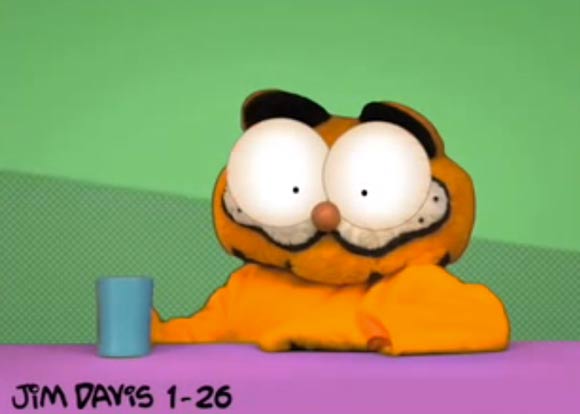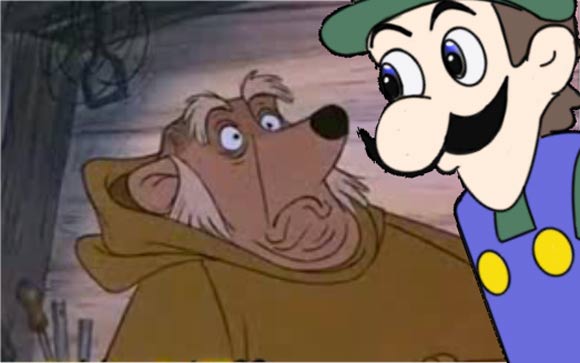

How Garfield Got His Groove Back: The ‘Garfield’ Remix Phenomenon

Poor Garfield. In his heyday, he was amongst the most beloved characters on the funny pages, his plush likenesses fastened to car windows and his sarcastic barbs adorning office walls around the globe. Then, somewhere along the line, he underwent a pop-cultural re-evaluation. Jim Davis’ strip is now something of a pariah: just look at how The Simpsons paired it with Love Is as the kind of strip that Milhouse reads. What a comedown for a character once hip enough to be quoted in “Two Tribes” by Frankie Goes to Hollywood.
But yet, the orange cat has been saved from cultural oblivion by a peculiar trend: the remixed Garfield strip.
This appears to have started in 2004, when Dan Fitch published his Garfield Shuffler online. Swiftly shut down for legal reasons but later recreated on various other websites under titles such as Garfield Randomizer and Random Garfield Generator, this piece of coding creates a completely meaningless Garfield strip out of three randomly-chosen panels. After the removal of the original Shuffler, Fitch gave some advice to his readers: “[F]or maximum Zen enjoyment of Garfield, read only the first two panels of each strip.” Whether he knew it or not, he was sowing the seeds for a trend that would keep building into something bigger.

At the Truth and Beauty Bombs forum in 2006, member “MackJ” made a curious discovery. By removing Garfield’s thought balloons, the strip can be turned into the melancholy story of a lonely man talking to his cat. Various other members of the forum got in on the act and the thread went viral, leading to no less a cultural figure than Neil Gaiman discussing it at his blog. Garfield would never be the same again.

Later remixes took the idea a few steps further. Realfield brings the man-talking-to-cat concept to its logical conclusion by using a more realistically-drawn animal, while Dan Walsh’s Garfield Minus Garfield removes the title character altogether, leaving the clearly desperate Jon talking to himself and occasionally experiencing inexplicable poltergeist-like phenomena.

Almost certainly the most elaborate Jim Davis remix is Lasagna Cat, an online video series starring a guy in a mildly unsettling Garfield costume. Each short starts out with a re-enactment of a particular strip, with the adaptation later being itself remixed into a music video – or, in one case, a Final Fantasy parody.
Finally we have Square Root of Minus Garfield, a site that allows readers to submit whatever Garfield remix (the preferred term here is “mash”) that they can think of. The results include Frank Miller parodies, curious experiments with Photoshop, throwbacks to 8-bit video games, and the long-awaited revelation of just what happened to that Lyman fellow.
So, why Garfield? Other funnies have been put through the mangler in similar ways – see Marmaduke Analyzed and Nietzsche Family Circus, to pick just two examples – but none to quite the same degree.
One reason that Garfield lends itself to this treatment is its drawing style. Unlike Marmaduke and similarly detailed strips, Garfield’s usage of stock poses and expressions means that it can be easily modified—almost like a Lego set.
Another factor is that, despite the amount of vitriol that is thrown at Garfield nowadays, the main characters still have life left in them. People clearly want to spend time with Jon and Garfield, even if the situations involved are not quite what Jim Davis ever had in mind.

The Garfield remixes have a lot in common with that curious phenomenon known as the “YouTube poop”: both derive humor from taking existing material and mashing it into nonsense. Although YouTube poops have made use of everything from Peter Pan to the BBC News, there are certain sources of video clips that have proven particularly fruitful.
The video acknowledged as the first YouTube poop (below), created in 2004 by “SuperYoshi”, is derived from one of DIC’s various Super Mario cartoons. Later videos in the genre have returned again and again to these series, along with the same company’s Adventures of Sonic the Hedgehog (Sonic’s archenemy, Dr. Robotnik, is something of a YouTube poop mascot) and the ropey animated cut-scenes from the Philips CD-i Legend of Zelda games. Indeed, so common is this subject matter that YouTube poop connoisseurs – and yes, such people apparently exist – have declared it to be “bland and overused”.
Various Internet memes remix characters in similar ways. Consider the innumerable Photoshopped images of people cowering in fear from the looming visage of “Weegee”, a vectorized version of a sprite from the 1992 video game Mario is Missing! Like the CD-i Zelda titles, this game was not created by Nintendo but rather a third party using Nintendo’s characters, resulting in comically off-model renditions. Similarly, the Spider-Man image macros popular at various forums prefer to use stills from the cheesy Sixties cartoon series, rather than the more polished depictions of the character that are available.

The examples above find comedy value in crude (but officially sanctioned) renditions of beloved video game and comic characters. Perhaps, in the spirit of Garfield Minus Garfield, we can summarize all this with a mathematical equation:
well-known character + poor-quality cartoon = limitless potential for online remixes
Garfield once possessed world-conquering popularity, but later suffered a fall from grace. In doing so, he fulfilled all the requirements for becoming a popular remix subject.
